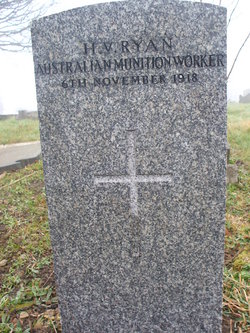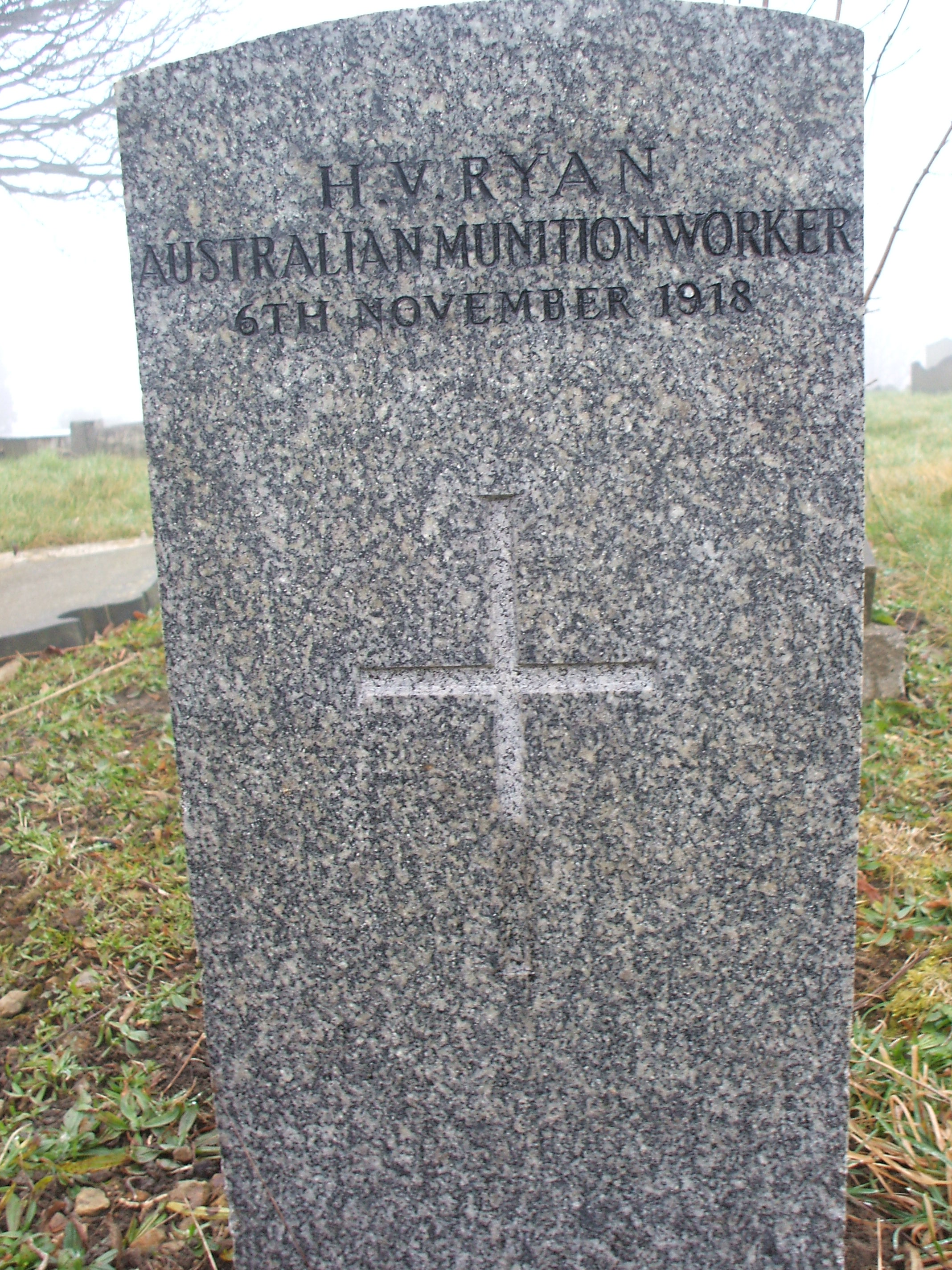It is believed that he served in the Boer War and with the Railways. On enlisting in New South Wales in February 1917 as War Worker number 397 on 26th February 1917, he stated that he had returned from South Africa, where he had been working on the Imperial Railway at the outbreak of war.
He arrived in the U.K. at Plymouth aboard the "A235 Suffolk" on 12th August 1917 after a 90 day voyage from Sydney and started work at Vickers as a plate layer earning £2.0.6d for a 54 hour week. He had accommodation in the wooden huts built along Petre Street.
The climate in Sheffield caused him many bronchial problems and it was at his doctor's surgery that he met and became engaged to the receptionist, Miss Agnes Smith. He requested that he be transferred to work in a cleaner climate like that at Bristol, however, while this was being considered he was admitted to Firvale Hospital, where on 6th November 1918 he died of Bronchial Pneumonia following Influenza.
Buried on 15th November 1918. The officiating minister was G. G. Hackforth.
The funeral arrangements were made by John Heath & Sons, at a cost of £8.15.0d. Vickers had sent men to the cemetery to dig the grave as there was an acute shortage of gravediggers at the time as able men had gone away to war and the influenza epidemic had arrived. At his funeral on 15th November 1918, he was bade farewell by eighty fellow Australian colleagues who had worked alongside him at Vickers Ltd. at Brightside.
He is remembered on the Australian National War Memorial.
The British Government requested skilled workers for munitions work from the Dominions and Colonies to make up the shortages caused by military service in this country
Australian War Memorial's Research Centre does not hold files relating to munitions workers and other skilled workers sent to the United Kingdom during the First World War. The National Archives of Australia has the service records for these men in the series MT1139/1 which consists of personnel dossiers for men enlisted under a joint Australian Commonwealth - Imperial Government scheme for providing skilled Australian workers to British war industries during the First World War. Under this scheme the volunteers would receive free passage to Great Britain, an allowance for travel time, a special allowance for the duration of service, and eventual repatriation to Australia. Married men also received a separation allowance, but were required to allot a portion of all their earnings to dependants. The men were expected to work in whatever industries they were directed to by the British Board of Trade, and under the prevailing conditions and wages for the duration of hostilities.
Government newspaper adverts appeared in August 1916, and the first party of 76 workers departed Australia in September. Groups continued to be recruited and sent at intervals, with the eventual number of workers under the scheme totalling just over 5,000. Almost 1,000 of these had already been working in Britain under private agreements with large firms such as Vickers, and were brought under the conditions of the scheme. An additional 200 former AIF soldiers were also recruited in Britain. Initially only skilled workers were sought, however at the request of the British Government later groups included large numbers of navvies for general labouring.
These men were not members of the Australian Imperial Forces and did not serve in combat units, but were recruited to meet the shortfall in skilled labour that threatened many of Britain's key wartime industries including munitions.
It is believed that he served in the Boer War and with the Railways. On enlisting in New South Wales in February 1917 as War Worker number 397 on 26th February 1917, he stated that he had returned from South Africa, where he had been working on the Imperial Railway at the outbreak of war.
He arrived in the U.K. at Plymouth aboard the "A235 Suffolk" on 12th August 1917 after a 90 day voyage from Sydney and started work at Vickers as a plate layer earning £2.0.6d for a 54 hour week. He had accommodation in the wooden huts built along Petre Street.
The climate in Sheffield caused him many bronchial problems and it was at his doctor's surgery that he met and became engaged to the receptionist, Miss Agnes Smith. He requested that he be transferred to work in a cleaner climate like that at Bristol, however, while this was being considered he was admitted to Firvale Hospital, where on 6th November 1918 he died of Bronchial Pneumonia following Influenza.
Buried on 15th November 1918. The officiating minister was G. G. Hackforth.
The funeral arrangements were made by John Heath & Sons, at a cost of £8.15.0d. Vickers had sent men to the cemetery to dig the grave as there was an acute shortage of gravediggers at the time as able men had gone away to war and the influenza epidemic had arrived. At his funeral on 15th November 1918, he was bade farewell by eighty fellow Australian colleagues who had worked alongside him at Vickers Ltd. at Brightside.
He is remembered on the Australian National War Memorial.
The British Government requested skilled workers for munitions work from the Dominions and Colonies to make up the shortages caused by military service in this country
Australian War Memorial's Research Centre does not hold files relating to munitions workers and other skilled workers sent to the United Kingdom during the First World War. The National Archives of Australia has the service records for these men in the series MT1139/1 which consists of personnel dossiers for men enlisted under a joint Australian Commonwealth - Imperial Government scheme for providing skilled Australian workers to British war industries during the First World War. Under this scheme the volunteers would receive free passage to Great Britain, an allowance for travel time, a special allowance for the duration of service, and eventual repatriation to Australia. Married men also received a separation allowance, but were required to allot a portion of all their earnings to dependants. The men were expected to work in whatever industries they were directed to by the British Board of Trade, and under the prevailing conditions and wages for the duration of hostilities.
Government newspaper adverts appeared in August 1916, and the first party of 76 workers departed Australia in September. Groups continued to be recruited and sent at intervals, with the eventual number of workers under the scheme totalling just over 5,000. Almost 1,000 of these had already been working in Britain under private agreements with large firms such as Vickers, and were brought under the conditions of the scheme. An additional 200 former AIF soldiers were also recruited in Britain. Initially only skilled workers were sought, however at the request of the British Government later groups included large numbers of navvies for general labouring.
These men were not members of the Australian Imperial Forces and did not serve in combat units, but were recruited to meet the shortfall in skilled labour that threatened many of Britain's key wartime industries including munitions.
Sponsored by Ancestry
Advertisement
Records on Ancestry
Sponsored by Ancestry
Advertisement



